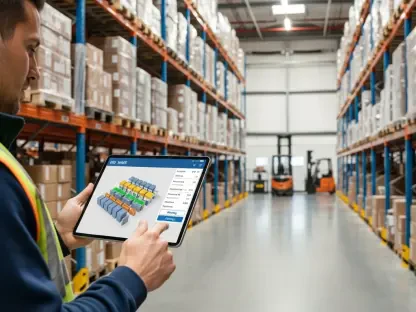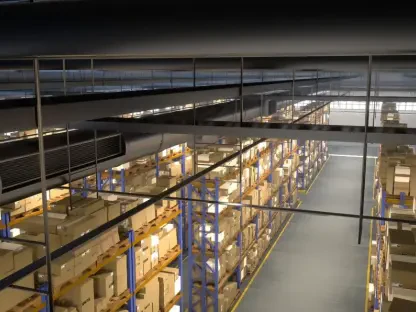Imagine a construction site grinding to a halt because critical equipment sits idle miles away, delayed by miscommunication or outdated scheduling systems, a scenario all too common in industries reliant on heavy machinery. This highlights a pressing need for streamlined operations. Fleet Cost & Care, a veteran in fleet management solutions, has rolled out a significant update to its dispatch software tailored for heavy equipment sectors like construction and environmental cleanup. This review dives deep into the capabilities of this technology, exploring how it addresses operational bottlenecks, enhances efficiency, and aligns with modern industry demands. The focus remains on dissecting key features, real-world impacts, and the potential this tool holds for transforming fleet management.
Understanding the Core of Heavy Equipment Dispatch Software
Heavy equipment dispatch software serves as a digital backbone for industries managing large machinery, optimizing how resources are allocated and workflows are executed. At its essence, this technology ensures that cranes, excavators, and other vital assets are deployed where and when they are needed, minimizing costly delays. The system leverages real-time data to provide visibility into equipment status, enabling managers to make informed decisions swiftly.
The rise of such software mirrors a broader push for digital transformation across industrial sectors. As companies grapple with tighter deadlines and shrinking margins, tools that integrate seamlessly with existing operations become indispensable. Fleet Cost & Care’s solution stands out by addressing these pressures head-on, offering a platform that not only tracks assets but also enhances overall productivity through smart automation.
This type of technology has evolved from basic scheduling tools into sophisticated systems that connect multiple facets of a business. Its relevance lies in bridging gaps between on-site needs and back-office planning, ensuring that every piece of equipment is utilized to its fullest potential. This review will unpack how the latest update builds on these foundations to deliver even greater value.
Key Features of Fleet Cost & Care’s Updated Dispatch Platform
Real-Time Data Analytics for Enhanced Dispatch Efficiency
One of the standout elements of this software update is its robust real-time data analytics. Fleet managers gain immediate access to insights on equipment availability, usage patterns, and maintenance schedules. This level of transparency allows for proactive adjustments, ensuring that machinery is always ready for deployment when critical projects demand it.
Beyond just tracking, the analytics feature helps identify potential issues before they escalate. For instance, predictive alerts can flag a crane due for servicing, preventing unexpected breakdowns that could stall operations. Such precision directly translates to reduced downtime, a metric that can make or break project timelines in high-stakes environments.
The impact of this capability extends to resource optimization as well. By having a clear view of which equipment is in use or idle, managers can avoid overbooking or underutilizing assets, striking a balance that maximizes efficiency. This feature alone positions the software as a game-changer for operational planning.
Seamless Integration with Accounting Systems
Another critical enhancement is the software’s ability to integrate effortlessly with existing accounting tools. This compatibility streamlines financial processes like invoicing and payroll, reducing manual input and the errors that often accompany it. For businesses juggling multiple projects, this means faster billing cycles and improved cash flow management.
The integration goes beyond mere data transfer; it creates a unified workflow where financial and operational data align in real time. This synchronization ensures that project costs are tracked accurately, providing a clearer picture of profitability for each job. Such clarity is invaluable for decision-makers aiming to refine budgeting strategies.
This feature also saves significant administrative time, allowing staff to focus on core tasks rather than getting bogged down in paperwork. By automating these backend processes, the software fosters a smoother operational rhythm, which is essential for companies managing complex fleets across diverse locations.
Mobile Safety and Compliance Tools via Atom App
Safety remains a top priority in industries handling heavy equipment, and the update introduces mobile applications like Atom to address this concern. This app empowers on-site teams to conduct inspections directly from their devices, ensuring compliance with stringent industry standards. Digital checklists and instant reporting minimize oversight risks in high-hazard settings.
The mobility aspect of this feature cannot be overstated. Workers can log safety checks or flag issues without needing to return to a central office, speeding up response times to potential hazards. This immediacy is crucial in environments where a single oversight could lead to significant safety incidents or costly penalties.
Additionally, the app supports documentation for audits, creating a reliable record of compliance efforts. This functionality not only protects businesses from regulatory repercussions but also builds trust with clients who prioritize safety protocols. It’s a practical solution that meets a fundamental need in the field.
Industry Trends Driving Dispatch Software Evolution
The development of heavy equipment dispatch software reflects broader industry trends toward digital efficiency and adaptability. Companies across construction and related sectors are increasingly relying on technology to tackle operational challenges, with real-time data and analytics becoming cornerstones of competitive advantage. Fleet Cost & Care’s update aligns perfectly with this shift, embedding cutting-edge tools into its platform.
Another notable trend is the demand for user-friendly, customizable solutions that cater to specific business needs. The emphasis on minimal retraining and intuitive design in this software speaks to a market preference for accessible technology. This approach ensures that even less tech-savvy operators can adopt the system without steep learning curves.
Safety and compliance are also shaping software advancements, as regulatory pressures mount in high-risk industries. By incorporating mobile inspection capabilities, the update responds to a growing consensus that technology must support workplace safety as much as efficiency. These trends collectively underscore why such innovations are not just optional but essential for staying relevant.
Real-World Applications and Broader Industry Impact
In practical settings, this dispatch software proves its worth across diverse industries like construction, excavation, and environmental cleanup. For instance, in large-scale building projects, the ability to track and deploy equipment in real time prevents delays that could derail tight schedules. This reliability directly boosts project completion rates and client satisfaction.
Unique use cases further highlight its versatility. Sales teams, often bogged down by administrative tasks, benefit from tools like the Sales Assistant, which shifts their focus to revenue-generating activities. This reallocation of effort can significantly enhance business growth, especially for firms balancing operational and commercial priorities.
The broader impact on industries is evident in improved productivity and cost savings. By curbing idle time and optimizing resource use, the software helps firms manage leaner operations without sacrificing output. This efficiency ripple effect can redefine how heavy equipment businesses scale and compete in crowded markets.
Challenges and Barriers to Adoption
Despite its advantages, adopting this kind of software isn’t without hurdles. Initial implementation costs can be a sticking point for smaller firms with limited budgets, as the upfront investment may seem daunting. Additionally, integrating new technology with legacy systems often poses technical complexities that require careful navigation.
Resistance to change among operators is another potential barrier. Long-standing reliance on manual processes can breed skepticism toward digital solutions, slowing adoption rates. Addressing this mindset shift is critical for ensuring the software’s benefits are fully realized across all levels of an organization.
Fleet Cost & Care mitigates these challenges through thoughtful design and support. The user-friendly interface reduces the need for extensive retraining, while dedicated customer service and consulting ease the transition. Continuous improvements based on client feedback also show a commitment to refining the system to meet diverse needs.
Future Prospects for Dispatch Software in Fleet Management
Looking ahead, the trajectory of heavy equipment dispatch software points toward even greater innovation. Potential advancements, such as AI-driven analytics, could further refine decision-making by predicting equipment needs with uncanny accuracy. Such developments would push efficiency to new heights over the coming years, from now through 2027.
Expanding mobile functionalities also holds promise, with apps potentially evolving to handle more complex on-site tasks. Imagine a future where workers manage entire project logistics from a single device, further collapsing the gap between field and office operations. This scalability could redefine workflow standards in the industry.
The long-term impact on heavy equipment sectors could be profound, with cost reductions and safety improvements becoming more pronounced. As technology matures, businesses might achieve unprecedented levels of operational agility, positioning them to tackle larger, more ambitious projects. This evolution signals a transformative era for fleet management.
Final Thoughts on Fleet Cost & Care’s Dispatch Software
Reflecting on this review, it’s clear that Fleet Cost & Care’s dispatch software update marks a pivotal step forward for heavy equipment management. Its blend of real-time analytics, seamless integrations, and safety-focused mobile tools delivers tangible benefits, from slashing downtime to enhancing compliance in demanding fields. The platform’s design tackles core industry pain points with precision and foresight.
For businesses navigating the complexities of fleet operations, the next step involves exploring tailored consulting offered by the provider to align the software with specific goals. Evaluating scalability needs also proves essential, ensuring the technology can grow alongside expanding operations. These actions promise to maximize the investment and sustain competitive edges.
Looking beyond immediate adoption, considering partnerships for ongoing feedback and feature updates emerges as a strategic move. Such collaboration could shape the software’s evolution, keeping it attuned to shifting industry demands. This proactive stance offers a pathway to not just adapt, but to lead in an increasingly digital landscape.









